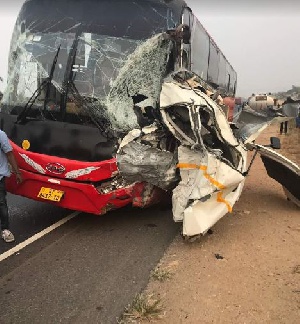The Accra–Kumasi Highway, a vital lifeline between Ghana’s two major economic hubs, has devolved into a fatal stretch of road that claims hundreds of lives each year. Investigative journalist Kwabena Adu Koranteng has sounded the alarm—calling for a state of emergency and immediate reconstruction into a dual carriageway, to stem the deadly tide.
A Hazardous Landscape: Daily Dangers Across Multiple Zones
From Pokuase to Nsawam, Suhum to Nkawkaw, and beyond—through Dadieso, Asankare, Atwedie, Juaso, Nkwanta, Konongo, to Ejisu—the road is pocked with deep potholes and manholes, often exacerbated by poor weather and night-time darkness due to lack of streetlights. In these single-lane sections, heavy trucks, tankers, buses, and mini-buses must share limited space, making overtaking perilous and crashes frequent.
Local accounts bring the tragedy into bold relief:
Rose Nkansa, a tiger nut hawker in Nkawkaw, says she has seen numerous crashes, including a recent collision between a fully loaded Toyota Hiace and a Kia Bongo truck, resulting in several severe injuries.
Sam Arthur, a mechanic, stresses the road’s inadequacy for its heavy traffic volume. He warns, “At night, you can barely see ahead. With no street lights, one wrong move can cost lives.”
Urgent Pleas, No Action
Despite repeated warnings, residents and transport unions feel the government is dragging its feet. Critics argue that every delayed day costs more lives—and the mounting death toll makes the need for action inescapable.
The Tragedy Over Time
National Context & Broader Trends
Between 1991 and 2019, Ghana recorded approximately 10,365 traffic crashes annually, leading to 47,783 deaths, 147,208 serious injuries, and 200,703 minor injuries .
As of 2012, Ghana recorded 2,249 deaths from road accidents and 14,181 injuries. Between 2008 and 2012, a total of 9,446 lives were lost, and 55,798 people were injured .
The Motor Transport and Traffic Directorate (MTTD) notes that road accidents claim an average of 4 lives a day, and between 2007 and 2010, 6,000 deaths and 40,000 injuries were recorded .
Kumasi–Konongo Corridor (1999–2009)
A detailed crash study reveals:
Total crashes: 1,442
Fatal crashes: 280 (about 19–20% of all crashes)
Hospitalized: 388
Non-hospitalized injuries: 337
Total casualties (all types): 2,634, including 395 fatalities (15%) .
Specific Recent Incidents on Accra–Kumasi Highway
February 2021: A gruesome head-on collision at Asafo-Akyem killed 19 people, including both drivers, after one bus attempted to overtake multiple trucks .
March 2023: A collision between two Toyota Hiace minibuses near Birimso claimed 9 lives, with 19 others injured .
April 2025: At Amanase near Suhum, a head-on crash between a fuel tanker and a Sprinter bus killed 11 people, with several more injured, allegedly due to driver fatigue .
Kumasi Urban Road Safety Improving — But Still Far from Safe
2021 to 2022: Fatal road accident deaths in Kumasi dropped from 160 to 134, a 16% reduction. However, total crashes rose from 1,255 to 1,550 .
In the Greater Accra Region (Jan–Oct 2023), there were 4,876 road crashes, resulting in 399 deaths and 2,776 injuries. Accidents involved private vehicles, commercial vehicles, motorbikes, and pedestrians, with males accounting for the vast majority of fatalities .
Hotspots Nationwide
In early 2018, over 230 people died and 2,671 were seriously injured in road accidents across Ghana—including on the Accra–Kumasi Highway .
Why the Numbers Matter
These statistics transform anecdotes into undeniable urgency:
Fatal crashes—especially recorded along critical segments—reflect systematic neglect of road infrastructure.
The highway’s record of single-digit to double-digit fatalities in major incidents (e.g., 11, 19, 9 deaths) underlines a pattern, not random misfortune.
While Kumasi has seen small improvements, broader trends reveal that Ghana’s road safety remains fragile, especially on high-volume intercity highways.
The repeated warnings, eyewitness testimonies, and grim statistics together make a somber case: the Accra–Kumasi Highway is more than an eyesore—it is a deadly artery. Only a state of emergency, backed with full-scale reconstruction into a dual carriageway and installation of lighting, enforcement of speed and fatigue regulations, and better emergency response systems, can begin to reverse this ongoing toll on human life.



